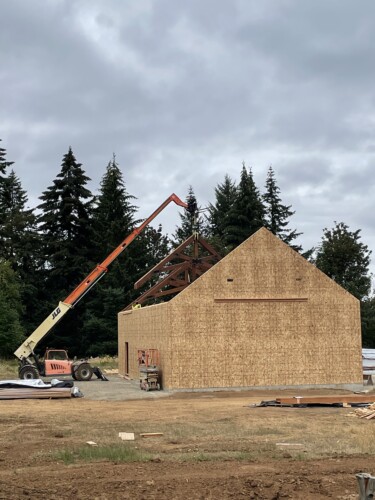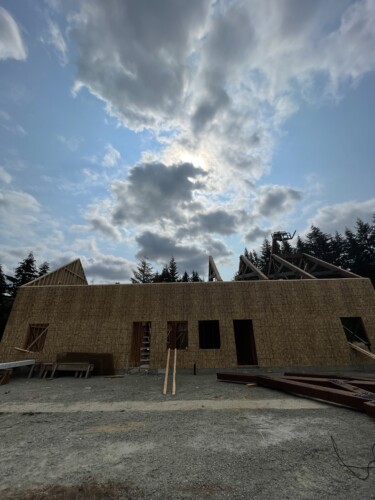 Houses and homes are among the most frequent elements appearing in dreams, with a wide range of literal and symbolic meanings.
Houses and homes are among the most frequent elements appearing in dreams, with a wide range of literal and symbolic meanings.
According to the Baseline frequencies of the Sleep and Dream Database, 47% of women’s dreams and 42% of men’s dreams include at least one architectural reference, with house, room, and home being mentioned the most often. These references are much more frequent than mentions of food and drink (14% women, 12% men), clothing (14% women, 11% men), and sexuality (4% women, 6% men). Among the vital necessities of life, the need for shelter seems to make the biggest impact on our dreaming experience. (Big Dreams, 104-105)
The frequency of houses in dreams surely reflects the large amount of time that many people spend in their homes. In literal terms, a house provides its occupants with safety, privacy, comfort, and warmth. As an enclosure built of durable materials, it separates inside from outside, domestic from public, family from stranger. For many homeowners, their house is their most valuable asset, a physical repository of their financial resources. This is why dreaming of a threat to one’s house, such as from fire or flooding, can be so disturbing. Especially in an era of rapid climate change, these kinds of worrisome house-danger dreams are likely to increase.
Dreams of houses also carry important symbolic meanings, in at least two different ways. One is the house as a symbol of family relations and childhood experiences. Dreams often cast us back into the homes we lived in as children many years ago, reminding us of how those experiences still shape and influence us today. A house can embody deep memories and formative events, both joyful and scary. What makes a house “haunted” in waking or dreaming is the uncanny presence of residents whose energies are still living even if they physically died long ago. When you dream of a childhood home, there may be a symbolic connection between something important that happened in that house and a difficult or challenging situation you are facing right now.
House dreams can also symbolize aspects of your mind and body. For instance, Carl Jung once dreamed of exploring a house with many different levels; as he descended from one floor to another, the décor changed from modern to ancient to paleolithic. Jung interpreted his dream as a symbolic portrayal of the human psyche, with modern consciousness at the “top” of the structure, and the depths of the collective unconscious at the “bottom.” Other psychologists treat house dreams as metaphors of the human body, with its various openings/orifices, its outer façade (“curb appeal”), secret inner spaces, plumbing and wiring, etc. If you have a house dream, it is worth considering how the condition of the building in the dream compares to the condition of your mind and body in waking life. Perhaps you discover the house needs maintenance or repair; maybe something especially tasty, or horribly nasty, is being cooked in the kitchen; you might find whole new rooms you have never explored before. Such dreams can use the familiar features of a house to help you better understand subtle, easily overlooked aspects of yourself.
House references in dreams can have both literal and symbolic levels of meaning, and the two levels often overlap. In American society, many people aspire to private home ownership in order to satisfy their literal need for shelter and also to mark their symbolic achievement of the “American Dream.” The common association of home ownership with the American Dream reflects an admirable striving for a good, settled, independent life. However, narrowly reducing the ideal of the American Dream to owning a private home can lead to an excessive focus on material gain and social status.
Note: this post first appeared in Psychology Today on January 6, 2025.

 Construction is going well so far on the Dream Library, a stand-alone structure on a rural, forested property near Portland, Oregon. As many friends and colleagues know, the project has taken a long time to reach this stage, but at last it’s beginning to take actual shape. The building will provide a long-term archive for dream-related materials such as journals, books, and art. The journal & book collections of Jeremy Taylor and Patricia Garfield will form the core of the library, along with other donated materials and my own collections.
Construction is going well so far on the Dream Library, a stand-alone structure on a rural, forested property near Portland, Oregon. As many friends and colleagues know, the project has taken a long time to reach this stage, but at last it’s beginning to take actual shape. The building will provide a long-term archive for dream-related materials such as journals, books, and art. The journal & book collections of Jeremy Taylor and Patricia Garfield will form the core of the library, along with other donated materials and my own collections.



 The bizarre contents of dreaming can easily seem like the products of mental deficiency. “Children of an idle brain” is what Mercutio calls them in Romeo & Juliet (I.iv.102). Many scientists today essentially agree with Mercutio that the weird absurdities of dreams are evidence of diminished cognitive functioning during sleep.
The bizarre contents of dreaming can easily seem like the products of mental deficiency. “Children of an idle brain” is what Mercutio calls them in Romeo & Juliet (I.iv.102). Many scientists today essentially agree with Mercutio that the weird absurdities of dreams are evidence of diminished cognitive functioning during sleep. The neuroscience of dreams has shifted in recent years toward the idea that dreaming can be conceived as a kind of mind-wandering in sleep. According to current evidence, mind-wandering (also known as day-dreaming, or drifting thought) is a product of the “default mode network,” a system of neural regions that remains active in the absence of external stimulus or focused thought. During sleep this same system of neural regions becomes active, helping to generate the experience of dreaming.
The neuroscience of dreams has shifted in recent years toward the idea that dreaming can be conceived as a kind of mind-wandering in sleep. According to current evidence, mind-wandering (also known as day-dreaming, or drifting thought) is a product of the “default mode network,” a system of neural regions that remains active in the absence of external stimulus or focused thought. During sleep this same system of neural regions becomes active, helping to generate the experience of dreaming. This is a post I recently wrote about the use of artificial intelligence (AI) systems in the practice of dream interpretation. In coordination with the team at the Elsewhere.to dream journaling app–Dan Kennedy, Gez Quinn, and Sheldon Juncker–we have been experimenting with “Freudian” and “Jungian” modes of interpretation, and the results are very encouraging. Maybe more than encouraging… I don’t highlight this in the post, but the AI interpretation in “Jungian” mode used the phrase “confrontation with the unconscious,” which was not part of the prompting text for the AI. In other words, the AI seems to have identified this phrase as a vital one in Jungian psychology (it’s the title of the pivotal chapter 6 of his memoir Memories, Dreams, Reflections) and, without any direct guidance, used it accurately and appropriately in an interpretation . I might even suspect a sly irony in using this phrase in reference to a dream of Freud’s, but that might be too much…
This is a post I recently wrote about the use of artificial intelligence (AI) systems in the practice of dream interpretation. In coordination with the team at the Elsewhere.to dream journaling app–Dan Kennedy, Gez Quinn, and Sheldon Juncker–we have been experimenting with “Freudian” and “Jungian” modes of interpretation, and the results are very encouraging. Maybe more than encouraging… I don’t highlight this in the post, but the AI interpretation in “Jungian” mode used the phrase “confrontation with the unconscious,” which was not part of the prompting text for the AI. In other words, the AI seems to have identified this phrase as a vital one in Jungian psychology (it’s the title of the pivotal chapter 6 of his memoir Memories, Dreams, Reflections) and, without any direct guidance, used it accurately and appropriately in an interpretation . I might even suspect a sly irony in using this phrase in reference to a dream of Freud’s, but that might be too much… Here are the recent posts I have written for Psychology Today, going back to the middle of last summer. Although each one is written as a stand-alone discussion of a special topic in dreaming, I now realize they also form a series of interrelated texts, like the chapters of a book I didn’t consciously know I was writing….
Here are the recent posts I have written for Psychology Today, going back to the middle of last summer. Although each one is written as a stand-alone discussion of a special topic in dreaming, I now realize they also form a series of interrelated texts, like the chapters of a book I didn’t consciously know I was writing….